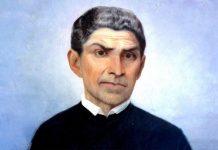Among the abbots of Cluny, St. Odilon stood out in a splendid way, fighting tirelessly for the Church and Christian Civilization.
Newsroom (July 28, 2022, 3:15 PM, Gaudium Press) The son of a nobleman from Auvergne – central France – who owned 15 fiefs, he was born in 962.
Since his childhood, he suffered from paralysis in his legs. One day, on a trip, his servants left him at the door of a church while they made some arrangements. The boy dragged himself, went to the altar of Our Lady, prayed for her help, and was cured. Thus was born his devotion to the Virgin.
As an adolescent, he entered a church dedicated to the Mother of God and consecrated himself to her as a slave. He was thus a forerunner of St. Louis Marie Grignion de Montfort, the great apostle of the sacred slavery to Our Lady.
Rebellious monks are scourged and expelled
In 991, he became a monk in the Monastery of Cluny. Shortly thereafter, the Abbot Saint Mayeul, who was quite old, appointed him abbot, for he feared that the infirmities proper to old age would prevent him from keeping monastic discipline in force. When St. Mayeul died in 994, St. Odilon was 32 years old. He held the office of abbot for 55 years.
He was thin, of small stature, and imposing in his gait. His sonorous and manly voice usually expressed a lot of sweetness, but sometimes it took on a terrible accent. With the humble monks he was kind and welcoming, but he treated the rebels firmly.
On one occasion, there was a bad ferment in Cluny. To prevent any rebellion, St. Odilon ordered the conspirator monks to be beaten with rods in front of the whole community, and then expelled.
The King of France wears the monastic habit
One of his first activities was to travel to Paris to reform the Abbey of Saint-Denis, whose monks were decaying. He often visited King Hugo Capeto in his palace on the Ile de la Città, in the center of the capital, who was old and sad – one would say today that he had been struck by depression. Saint Odilon advised him to go to the tomb of Saint Mayeul in the Monastery of Souvigny, where many miracles were performed.
The sovereign went there accompanied by his son Robert, who later became king and received the nickname “Pious. He stayed in the monastery and wanted to observe all the rules. He wore the monastic habit, occupied a cell, and, in the refectory, was served like any other religious. He sang the Office during the day and also at night. When he recovered, he returned to Paris full of joy.
In the Cluniac monasteries, no meat was eaten, but wine was served every day. Extraordinary cleanliness was demanded of the novices. The monks of Cluny could be compared to “an immense army of the Lord’s soldiers, hierarchical”[1], captained by the abbot.
Due to serious issues in the diocese of Lyon – one of the most important in France – Pope John XVIII sent the pallium and the bishop’s ring to Saint Odilon, begging him to take over that diocese. He refused, saying he had to take care of the Order of Cluny, which included many monasteries. The pontiff reiterated his request, but St. Odilon did not accept.
God’s Truce
At that time, there were frequent bloody battles between Catholics over issues of borders, prestige, etc. In order to stop these fratricidal wars, on the initiative of Saint Odilon, the ecclesiastical religious authorities determined the Truce of God.
In honor of the institution of the Holy Eucharist, of the Passion and Death of Our Lord, and of his Resurrection, fighting among Catholics was forbidden, from sunset on Wednesday until dawn on Monday. Whoever disrespected this precept received severe ecclesiastical punishments, up to and including excommunication.
Obviously, wars against enemies of the Church were not included in this prohibition. So much so that, in 1095, in the Council of Clermont – South of France – Blessed Urban II preached the Crusade against the Mohammedans, who had taken Jerusalem and were persecuting Catholics.
In such a way St. Odilon spread and improved the Order of Cluny that it became “the new force, pure and implacable, destined to destroy the rotten frames of Christian society and to make virtue and the fear of God reign everywhere, despite all the simonious and debauched bishops.”[2]
“The entire Cluniac congregation is considered as constituting a single monastery, and the abbot of Cluny is the abbot of all, the abbot general. The priors, that is, the superiors of the local communities, are appointed by the abbot.”[3]
And Benedict VIII, pontiff from 1012 to 1024, declared that Cluny was free from subjection to bishops, kings, and nobles, and owed submission only to God and the Pope.
Heart of the Catholic Church
Many miracles were performed through the intercession of St. Odilon, such as the multiplication of fishes, the dry crossing of rivers, and the turning of water into wine.
In the last five years of his life, he suffered violent stomach pains, but his pains did not diminish at all. He went to Rome where he met Hildebrando – the future Saint Gregory VII – who had studied in a Cluniac monastery in the Eternal City.
Returning to France, he stayed at the monastery of Souvigny. Feeling that death was approaching, he asked to be laid on the ground already covered with ashes and with the sackcloth he was wearing. Looking at a crucifix, from his lips a smile broke out and he gave his soul to God on January 1, 1049, at the age of 87.[4]
Monsignor João Scognamiglio Clá Dias writes:
“Saint Odilon stands out as the most expressive glory of Cluny and stands at the root of all the splendors of the Middle Ages.”
“His generous surrender into the hands of Our Lady makes him a predecessor of St. Louis Grignion de Montfort and inserts him in the vein of Marian souls who, by radiating the most select graces of the Redeemer, granted only through his Mother, make up the heart of the Catholic Church.”[5]
By Paulo Francisco Martos
Notions of Church History
[1] DANIEL-ROPS, Henri. The Church in Barbarian times. São Paulo: Quadrante. 1991, v. II, p. 592.
[2] POGNON, Edmond. L’an mille. Apud DANIEL-ROPS, Henri. The Church in Barbarian times. São Paulo: Quadrante. 1991, v. II, p. 592-593.
[3] DANIEL-ROPS, Henri. Op. cit.
[4] Cf. PIGNOT. Jean-Henri. Histoire de l’ordre de Cluny, depuis la fondation de l’abbaye jusqu’à la mort de Pierre-le-Vénérable (909-1157). Paris: Durand, Libraire. 1868, v. 1, p. 306,365,461. passim. GOBRY, Ivan. Les moines en Occident. Paris: François-Xavier de Guibert. 2005, v. 4, p. 209,217,224.
[5] CLÁ DIAS, João Scognamiglio, EP. Maria Santíssima! The Paradise of God revealed to men. São Paulo: Heralds of the Gospel. 2020, v. III, p. 80.
Compiled by Sarah Gangl
































